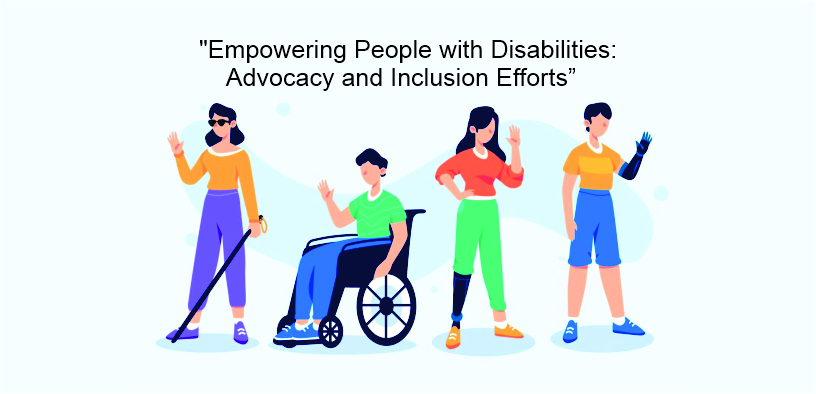Empowering people with disabilities is not just a matter of addressing their specific needs but also a reflection of a society’s commitment to human rights, equality, and inclusion. People with disabilities have historically faced various challenges, ranging from physical barriers to societal stigmatization.
However, in recent years, advocacy and inclusion efforts have gained momentum, promoting the rights and well-being of individuals with disabilities. One organization that exemplifies these efforts is Narayan Seva Sansthan, which has been instrumental in transforming the lives of countless individuals with disabilities in India.
1: Advocacy for Disability Rights
1: Legislative Initiatives
The rights of people with disabilities are typically the focus of advocacy initiatives, leading to legislative lobbying. The Americans with Disabilities Act (ADA) in the United States and the United Nations International Convention on the Rights of Persons with Disabilities are two examples of laws protecting the rights of people with disabilities that could be the focus of such efforts. Additionally, advocates may push for new laws and policies that address emerging issues faced by the disabled community.
2: Awareness Campaigns
Raising awareness about disability issues is essential for fostering empathy, understanding, and support for people with disabilities. Awareness campaigns can utilize various media platforms to educate the public about the challenges and accomplishments of individuals with disabilities. By changing societal attitudes and dispelling myths, these campaigns help combat stigmatization and discrimination.
2: Inclusive Education
1: Universal Design for Learning (UDL)
Universal Design for Learning (UDL) is an educational approach that promotes inclusive learning environments for students with diverse abilities. UDL principles involve providing multiple means of representation, engagement, and expression to accommodate different learning styles and needs. By implementing UDL in classrooms, educational institutions can create inclusive spaces that enable students with disabilities to thrive alongside their peers.
2: Individualized Education Plans (IEPs)
Individualized Education Plans (IEPs) are personalized plans designed to meet the unique needs of students with disabilities. These plans outline specific accommodations, modifications, and support services required for the student’s academic success. IEPs foster collaboration between educators, parents, and other professionals to ensure that students with disabilities receive the necessary resources and assistance.
3: Employment and Workplace Inclusion
1: Disability Employment Initiatives
Advocacy efforts for workplace inclusion often involve promoting disability employment initiatives. These initiatives may include setting diversity and inclusion targets for hiring individuals with disabilities, creating supportive work environments, and offering reasonable accommodations to enable employees with disabilities to perform their duties effectively.
2: Vocational Training and Skill Development
Vocational training and skill development programs play a vital role in empowering people with disabilities to gain relevant skills and knowledge for meaningful employment. These programs can help bridge the gap between education and the workplace, providing individuals with disabilities with the confidence and competence they need to pursue their career goals.
4: Accessible Infrastructure and Technology
1: Accessible Public Spaces
Advocates work towards creating accessible public spaces that accommodate the needs of individuals with disabilities. This includes ensuring that buildings, transportation systems, and recreational facilities are designed with universal accessibility in mind, allowing people with disabilities to navigate these spaces independently.
2: Assistive Technology and Innovation
The advancement of assistive technology has been a game-changer for people with disabilities. Advocacy efforts in this area involve promoting the development and affordability of assistive devices and software that enhance the independence and quality of life for individuals with disabilities.
5: Healthcare and Disability Services
1: Accessible Healthcare Facilities
Access to quality healthcare is essential for people with disabilities to maintain their well-being and lead fulfilling lives. Advocacy efforts in this area focus on ensuring that healthcare facilities are physically accessible and have trained staff who can cater to the specific needs of individuals with disabilities. It also involves advocating for health insurance plans that cover disability-related treatments and assistive devices.
2: Mental Health Support
People with disabilities may face unique mental health challenges due to the intersection of their disability and societal attitudes. Advocacy efforts aim to promote mental health support services that are inclusive and sensitive to the needs of individuals with disabilities. This may include providing accessible counseling, support groups, and resources tailored to their specific mental health requirements.
6: Social Inclusion and Community Engagement
1: Disability Awareness Programs
Disability awareness programs are designed to educate the public about disabilities and promote social inclusion. These programs foster empathy and understanding, encourage interaction and engagement with people with disabilities, and challenge stereotypes. By creating an inclusive and accepting community, individuals with disabilities can feel valued and included.
2: Recreational and Cultural Opportunities
Advocacy efforts in this area focus on ensuring that recreational and cultural activities are accessible to people with disabilities. This may involve encouraging recreational facilities, museums, theaters, and other cultural venues to be physically accessible and provide accommodations for individuals with diverse abilities to participate fully.
7: Empowerment through Self-Advocacy
1: Self-Advocacy Training
Empowering individuals with disabilities to become self-advocates is a crucial aspect of disability empowerment. Self-advocacy training equips individuals with the knowledge and skills to express their needs, rights, and preferences effectively. This can lead to greater independence and autonomy in decision-making.
2: Disability Leadership Programs
Disability leadership programs provide opportunities for people with disabilities to take on leadership roles within their communities and organizations. These programs help amplify the voices of individuals with disabilities, enabling them to advocate for change, influence policies, and serve as role models for others.
8: Vocational Training
1: Computer Skills Training:
NGOs like Narayan Seva Sansthan provide specialized training in computer proficiency, equipping students with essential tech-savvy skills.
2: Mobile Repairing and Tailoring:
The organization offers hands-on training in mobile repairing and tailoring, ensuring individuals are armed with tangible skills that bolster employability.
Conclusion
Empowering people with disabilities requires collective efforts from governments, civil society, and individuals. Advocacy and inclusion initiatives are crucial in dismantling barriers and fostering an inclusive society. Narayan Seva Sansthan stands as a shining example of an organization that has taken bold strides to empower people with disabilities and create a more equal and compassionate world.








